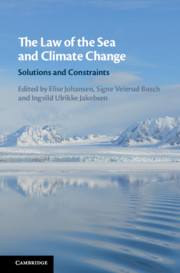Book contents
- The Law of the Sea and Climate Change
- The Law of the Sea and Climate Change
- Copyright page
- Contents
- Contributors
- Preface
- Acknowledgements
- International Instruments
- Table of Cases
- Abbreviations
- 1 The Role of the Oceans in Regulating the Earth’s Climate
- 2 Climate Change and the Anthropocene
- 3 Mitigation and Adaptation
- 4 Protecting the Marine Environment from Climate Change
- 5 Ocean Acidification
- 6 Regulating Greenhouse Gases from Ships
- 7 Carbon Capture and Storage and the Law of the Sea
- 8 Ocean Fertilization
- 9 Offshore Renewable Energy and the Law of the Sea
- 10 Marine Protected Areas and Climate Change
- 11 Integrating Climate Change in International Fisheries Law
- 12 Adaptation of Aquaculture to Climate Change
- 13 Law of the Sea Responses to Sea-Level Rise and Threatened Maritime Entitlements
- 14 Integrating Climate Change in the Governance of Areas beyond National Jurisdiction
- 15 The Law of the Sea and Its Institutions
- 16 The Law of the Sea as Part of the Climate-Change Regime Complex
- Bibliography
- Index
6 - Regulating Greenhouse Gases from Ships
Some Light at the End of the Funnel?
Published online by Cambridge University Press: 21 January 2021
- The Law of the Sea and Climate Change
- The Law of the Sea and Climate Change
- Copyright page
- Contents
- Contributors
- Preface
- Acknowledgements
- International Instruments
- Table of Cases
- Abbreviations
- 1 The Role of the Oceans in Regulating the Earth’s Climate
- 2 Climate Change and the Anthropocene
- 3 Mitigation and Adaptation
- 4 Protecting the Marine Environment from Climate Change
- 5 Ocean Acidification
- 6 Regulating Greenhouse Gases from Ships
- 7 Carbon Capture and Storage and the Law of the Sea
- 8 Ocean Fertilization
- 9 Offshore Renewable Energy and the Law of the Sea
- 10 Marine Protected Areas and Climate Change
- 11 Integrating Climate Change in International Fisheries Law
- 12 Adaptation of Aquaculture to Climate Change
- 13 Law of the Sea Responses to Sea-Level Rise and Threatened Maritime Entitlements
- 14 Integrating Climate Change in the Governance of Areas beyond National Jurisdiction
- 15 The Law of the Sea and Its Institutions
- 16 The Law of the Sea as Part of the Climate-Change Regime Complex
- Bibliography
- Index
Summary
Developing standards for reducing greenhouse gas (GHG) emissions from ships involves various challenges of a technical, regulatory and political nature. The main role of the 1982 UN Convention on the Law of the Sea (LOSC) here, as with the prevention of pollution from ships more generally, is to ensure that a uniform set of standards applies across the globe. What those standards should be is up to other institutions to decide: the LOSC does not specify which institution(s) should be in charge, or even whether there is an obligation for any institution to act in this field. However, pressure from multiple directions has been mounting on the international maritime community to achieve significant reductions in GHG emissions from shipping. The perspective taken in this chapter is mainly an institutional one, focusing on the inter-relatedness and interaction between different legal regimes in a matter which still struggles to find its regulatory format.
- Type
- Chapter
- Information
- The Law of the Sea and Climate ChangeSolutions and Constraints, pp. 129 - 159Publisher: Cambridge University PressPrint publication year: 2020
- 2
- Cited by



